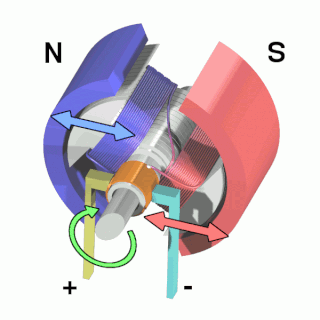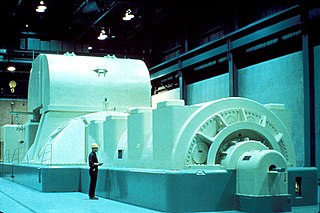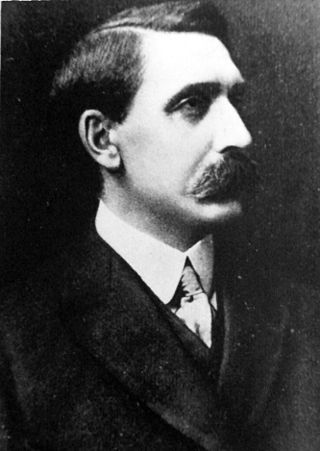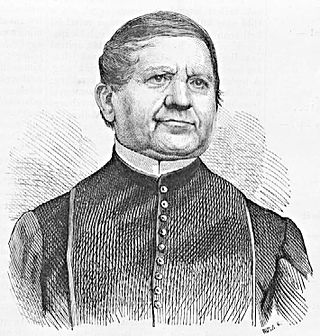Related Research Articles

Michael Faraday was an English scientist who contributed to the study of electromagnetism and electrochemistry. His main discoveries include the principles underlying electromagnetic induction, diamagnetism and electrolysis. Although Faraday received little formal education, he was one of the most influential scientists in history. It was by his research on the magnetic field around a conductor carrying a direct current that Faraday established the concept of the electromagnetic field in physics. Faraday also established that magnetism could affect rays of light and that there was an underlying relationship between the two phenomena. He similarly discovered the principles of electromagnetic induction, diamagnetism, and the laws of electrolysis. His inventions of electromagnetic rotary devices formed the foundation of electric motor technology, and it was largely due to his efforts that electricity became practical for use in technology.

An electric motor is an electrical machine that converts electrical energy into mechanical energy. Most electric motors operate through the interaction between the motor's magnetic field and electric current in a wire winding to generate force in the form of torque applied on the motor's shaft. An electric generator is mechanically identical to an electric motor, but operates with a reversed flow of power, converting mechanical energy into electrical energy.

Sir Charles Wheatstone FRS FRSE, was an English scientist and inventor of many scientific breakthroughs of the Victorian era, including the English concertina, the stereoscope, and the Playfair cipher. However, Wheatstone is best known for his contributions in the development of the Wheatstone bridge, originally invented by Samuel Hunter Christie, which is used to measure an unknown electrical resistance, and as a major figure in the development of telegraphy.

In electricity generation, a generator is a device that converts motive power or fuel-based power into electric power for use in an external circuit. Sources of mechanical energy include steam turbines, gas turbines, water turbines, internal combustion engines, wind turbines and even hand cranks. The first electromagnetic generator, the Faraday disk, was invented in 1831 by British scientist Michael Faraday. Generators provide nearly all of the power for electric power grids.

The Royal Society for the Encouragement of Arts, Manufactures and Commerce (RSA), commonly known as the Royal Society of Arts, is a London-based organisation committed to finding practical solutions to social challenges.

Sir Carl Wilhelm Siemens, anglicised to Charles William Siemens, was a German-British electrical engineer and businessman.

John Hopkinson, FRS, was a British physicist, electrical engineer, Fellow of the Royal Society and President of the IEE twice in 1890 and 1896. He invented the three-wire (three-phase) system for the distribution of electrical power, for which he was granted a patent in 1882. He also worked in many areas of electromagnetism and electrostatics, and in 1890 was appointed professor of electrical engineering at King's College London, where he was also director of the Siemens Laboratory.

Edward Cardwell, 1st Viscount Cardwell, was a prominent British politician in the Peelite and Liberal parties during the middle of the 19th century. He is best remembered for his tenure as Secretary of State for War between 1868 and 1874 and, with William Ewart Gladstone's support, the introduction of the Cardwell Reforms. The goal was to centralise the power of the War Office, abolish purchase of officers' commissions, and to create reserve forces stationed in Britain by establishing short terms of service for enlisted men.
The Manchester Literary and Philosophical Society, popularly known as the Lit. & Phil., is one of the oldest learned societies in the United Kingdom and second oldest provincial learned society.

Sebastian Pietro Innocenzo Adhemar Ziani de Ferranti was a British electrical engineer and inventor.
The Bakerian Medal is one of the premier medals of the Royal Society that recognizes exceptional and outstanding science. It comes with a medal award and a prize lecture. The medalist is required to give a lecture on any topic related to physical sciences. It is awarded annually to individuals in the field of physical sciences, including computer science.

Ányos István Jedlik was a Hungarian inventor, engineer, physicist, and Benedictine priest. He was also a member of the Hungarian Academy of Sciences, and author of several books. He is considered by Hungarians and Slovaks to be the unsung father of the dynamo and electric motor.

A homopolar generator is a DC electrical generator comprising an electrically conductive disc or cylinder rotating in a plane perpendicular to a uniform static magnetic field. A potential difference is created between the center of the disc and the rim with an electrical polarity that depends on the direction of rotation and the orientation of the field. It is also known as a unipolar generator, acyclic generator, disk dynamo, or Faraday disc. The voltage is typically low, on the order of a few volts in the case of small demonstration models, but large research generators can produce hundreds of volts, and some systems have multiple generators in series to produce an even larger voltage. They are unusual in that they can source tremendous electric current, some more than a million amperes, because the homopolar generator can be made to have very low internal resistance. Also, the homopolar generator is unique in that no other rotary electric machine can produce DC without using rectifiers or commutators.
The Albert Medal of the Royal Society of Arts (RSA) was instituted in 1864 as a memorial to Prince Albert, who had been President of the Society for 18 years. It was first awarded in 1864 for "distinguished merit in promoting Arts, Manufactures and Commerce". In presenting the Medal, the Society now looks to acknowledge individuals, organizations and groups that lead progress and create positive change within contemporary society in areas that are linked closely to the Society's broad agenda.

Moses Gerrish Farmer was an electrical engineer and inventor. Farmer was a member of the AIEE, later known as the IEEE.

The history of electromagnetic theory begins with ancient measures to understand atmospheric electricity, in particular lightning. People then had little understanding of electricity, and were unable to explain the phenomena. Scientific understanding into the nature of electricity grew throughout the eighteenth and nineteenth centuries through the work of researchers such as Coulomb, Ampère, Faraday and Maxwell.
Nathaniel Shepard Keith was an American manufacturer, chemist, inventor, writer, and electrical engineer. Keith was born in Boston, Massachusetts, and worked in his fathers laboratory. He was instrumental in designing, manufacturing, and installing the original electric lighting and power system in San Francisco, California. In 1884 he became editor of Electric World, co-founded the American Institute of Electrical Engineers (AIEE) and served as the first secretary of the organization. The AIEE merged with other societies in 1963 to become the IEEE, the Institute of Electrical and Electronics Engineers.

A dynamo is an electrical generator that creates direct current using a commutator. Dynamos were the first electrical generators capable of delivering power for industry, and the foundation upon which many other later electric-power conversion devices were based, including the electric motor, the alternating-current alternator, and the rotary converter.

A magneto is an electrical generator that uses permanent magnets to produce periodic pulses of alternating current. Unlike a dynamo, a magneto does not contain a commutator to produce direct current. It is categorized as a form of alternator, although it is usually considered distinct from most other alternators, which use field coils rather than permanent magnets.
Francis Whishaw was an English civil engineer. He was known for his role in the Society of Arts, and as a writer on railways. Later in life he was a promoter of telegraph companies.
References
- Donald Cardwell, James Joule: A Biography, Manchester University Press ND, 1989 ISBN 0-7190-3479-5.